The flying winemaker, Samuel Tinon, who migrated from Bordeaux to Tokaj, has worked, apart from in his homeland, in Australia, Chile, Italy, Texas, finally settling in Tokaj, first as director of Royal Tokaj and then as the winemaking consultant to Oremus Wine Estate. Then and now, as he has only been running his own winery recently, Samuel’s aim has been the development of Tokaj’s international fame, by producing the oldest, most distinctive wine types of the region, Aszú and Szamorodni.
His vineyard in Olaszliszka is no larger than five hectares and he produces mostly Furmint, his Hárslevelű plantings total just half a hectare. His bush trained vines are relatively old, some more than 70 years old. Samuel doesn’t use any chemicals, but the land, the Határi vineyard is steep, so he has to manage his grape growing with the most natural method, that is with his very own hands, without even the help of a tractor or horse.
Tinon has earned serious professional prestige in both Hungary and France for his wines, not only for his sweet but also for his dry Szamorodnis. However, his wines are not too well-known in Hungary, but one reason for this it is that almost all his annual production of 10-15,000 bottles is sold abroad, mostly in Paris.
We have to point out that not too many people in Tokaj are capable of achieving the quality level of Tinon’s dry Szamorodnis. Elsewhere in the world, wines are made using such technology (barrel aging under a layer of flor for many years) only in the Jura region of France and most likely they acquired this knowledge from Tokaj at some point in the 18th century. Anyway, whether we are talking about Tinon’s dry or his sweet wines (Aszú, Szamorodni, Aszú Essencia), according to the winemaker “there is only one style, the Tokaj style. This is experience garnered over 3-400 years. Those who want to make real Tokaji have to find and follow this. They have to learn from the wine region and let the raw material show itself; learn how these great wines were made centuries ago, wines which were able to delight kings even after travelling thousands of kilometres. They have to achieve this style”.
Today, now that the Tokaj-Hegyalja wine region is focusing mainly on dry wines, and within that category, on vineyard-selected Furmints, Samuel Tinon is not following this trend – they only represent a few percent of his whole range. But the winemaker gives a simple answer to this secret. As he sells most of his wines in France, he works with types of wine which he can demonstrate as unique there, within that environment. The dry Furmint, however, he says, has not yet really caught on in his homeland. The dry Szamorodni is all right, people smack their lips after that, even in Paris, but vineyard-selected dry Furmint has not yet awakened the locals’ imagination. If we consider that the Hegyalja style has focussed mostly on Aszú for 3-400 years and then from the 19th century on, Szamorodni too, it’s hardly surprising that a Tokaj product, the vineyard-selected dry Furmint, which has been in existence for a mere 15 years, has not managed to create so much prestige for itself on the global wine market that international merchants will make a grab for it. As we know, the USA and Scandinavian countries are the exceptions, but here we are talking about a relatively small number of bottles. And of course, there are exceptions in France too, but, according to Samuel, there is more penetration power if we put a Tokaji Aszú on the table next to a Monbazillac or a sweet Sauternes.






